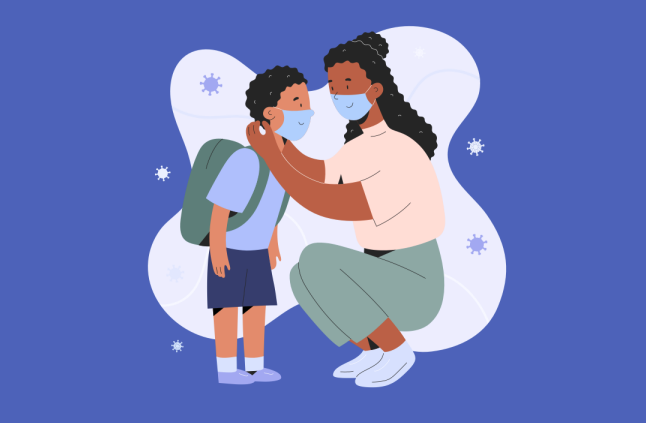Back-to-school season is traditionally marked by a run on discounted pencils, overcrowded malls and lots of nail-biting nerves about new teachers. But this year, the back-to-school season is entirely different. Forget the crowds and a race to find the hottest-selling backpack. This year, it’s all about the trendiest face masks and getting ready for a school year that promises to be unlike any other. And for a child, that can be more than a little frightening.
As with every transition, proper mindset and preparation is key to smoothing out the inevitable bumps and hurdles. Whether your school district is starting off the year exclusively with distance learning, going back to in-person learning five days a week or they’ve settled on something in between, we’ve got you covered.
Here’s our complete guide to helping you prepare your child for the new school year in these unconventional times.
Talk to your child about what to expect
The more your child knows about the dynamics of the upcoming school year, the better off they’ll be. As the situation evolves, and you learn more details about the year’s schooling, speak to your child about what to expect. If your school’s administration has decided to continue in-person instruction with daily temperature checks, let your child know to expect them. If the school year will start off with remote learning and tentative plans for returning to in-person instruction in January, share this information with your child. The more your child knows, the easier it will be for them to handle changes as events unfold.
Create a back-from-school protocol to keep your home safe
If your child will be going to school full-time, or even partially, it’s important to establish a sanitizing ritual for them to adhere to when they walk through the front door after each day of school.
“When children return from school, they should immediately sanitize their hands,” advises boardcertified pediatrician, Dr. Candice W. Jones. “Once at home, at the very least, they should remove clothes/shoes and place them in the laundry, or in a designated safe place for disinfecting. A shower would be great, but is not absolutely necessary.”
Talk to your child about this daily disinfecting routine, and run a practice round or two to make it easier to remember when school starts.
Zooming in on remote schooling
Many states and school districts have announced the continuation of distance learning for the start of the new school year. If the idea of sitting your child down in front of the screen for hours at a time again makes your head spin, it’s time to rethink your strategy. Dr. Linda Carling, an associate research scientist at Johns Hopkins University, shares these tips for helping children succeed at remote learning:
• Encourage movement. Squeeze in some stretching breaks throughout the school day and pencil in larger chunks of time for longer exercises, like a bike ride around the block. If your child finds it particularly difficult to sit still for long periods of time, set up a tablet or laptop on a raised surface and have your child stand through their classes.
• Reduce distractions. Create a distraction-free zone for your child’s learning to help boost their focus. Noise-canceling headphones can also be helpful to drown out auditory distractions.
• Adjust your schedule as needed. Many younger children need constant or intermittent guidance to help them with their remote learning. If possible, adjust your own schedule so you can be on hand to help your child as necessary.
• Use a checklist for focus. A basic visual checklist of tasks that need to be completed can help children focus. Draw up the checklist with your child at the beginning of each day and have them cross off tasks as they’re completed.
• Provide immediate positive feedback. Each time your child successfully follows instructions, provide immediate and positive feedback. You can keep it small, from a sticker on their work assignment or words of praise to an extra 15 minutes of play before bedtime.
Help your child prepare for face mask wearing while at school
School supply lists are looking very different this year, with “face masks” penciled in right next to “erasers” and “glue.” But having your child wear a mask for hours on end while sitting through school can sound next to impossible.
To help your child prepare for face mask wearing while at school, it’s best to model positivity.
It’s no secret that kids mimic the adults in their lives. Though you may find it difficult to wear a mask yourself, you can help your child build up a positive attitude about mask-wearing by talking about how your mask is keeping you and others safe, as well as how the discomfort is a small price to pay for safety.
It’s also a good idea to practice mask-wearing at home. This will serve the dual purpose of getting your child accustomed to wearing a mask, and help to ensure your child is wearing it correctly before school starts. If your child is particularly resistant to wearing a mask, you may want to employ some strategies, like having them wear the mask for the length of their favorite song, or playing dress-up as a doctor or your child’s favorite superhero.
For the sensory child, face masks can be a nightmare. Make it easier by finding the style that is most comfortable for your child, whether that’s a classic ear-loop mask, a bandanna style covering, or a neck gaiter. Extenders or button headbands can also be a welcome relief for irritated ears.
Finally, make masks fun by choosing a child-friendly pattern. You can go with these adorable bear face masks from Amazon, have your child design their own mask on Etsy, or pick out a mask featuring your child’s favorite movie character from Disney.
Get the school year off to a great start with these preparatory tips for you and your child.

